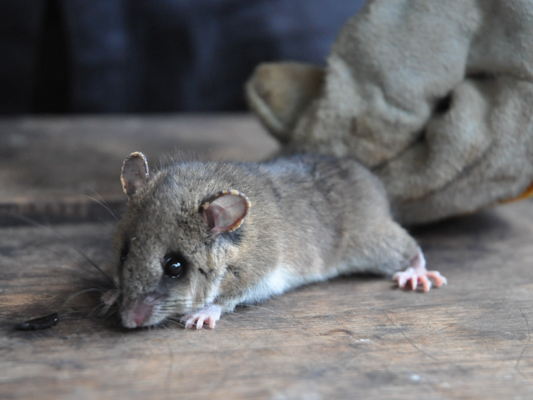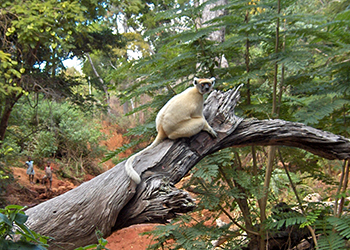
Population and Conservation Genetics
Lounes Chikhi
Genetic and genomic data are influenced by the demographic history of populations. This history is the result of events that include population collapses, expansions, or admixture processes. It also involves the connection and disconnection of populations (i.e. varying population structure). Such changes in population structure and connectivity can be caused by many factors, including climate change over short or long periods or human activities in both the most recent and ancient past.
The research group, led by Lounés Chikhi, is interested in the genetic consequences of such events. We are thus interested in the methods used to improve our understanding the recent evolutionary history of species and on the development of new methods or approaches to that aim.
They also, and crucially, want to understand the limits of genetic or genomic data as inferential tools. We thus ask: how much of what we write and publish should be considered as story-telling, and how much can be considered as solid. This is a question that may be much more open than we, as a community, may wish to admit.
Applications of the research is varied. Researchers have been working on humans (e.g. the Neolithic transition in Europe), and on many endangered species (e.g. orang-utans, lemurs, dolphins, African primates). They are also collaborating on projects involving domesticated species (e.g. cattle, sheep).
Work currently done at the Population and Conservation Genetics (PCG) group involves fieldwork in Madagascar, Guiné-Bissau and Portugal, and the genetic typing of endangered species or populations (lemurs, endemic and invasive rodents, red colobus, bottlenose dolphins), data analysis and simulation. We also work on more analytical work, even though this is mainly done through a collaboration with colleagues from Toulouse (see below).
Researchers are also moving towards the use of genomic data (RAD-seq and full genome sequencing). Who isn’t ? They collaborate with the laboratory Evolution & Diversité Biologique, in Toulouse, where Lounès Chikhi is a Senior researcher (Directeur de Recherche) and with colleagues from several institutions outside and inside Portugal. This includes the UK (Cardiff University, Bristol University), France (IMT - Institut de Mathématiques de Toulouse, INSA - Institut National des Sciences Appliquées de Toulouse, INRA - Institut National de Recherche Agronomique), Madagascar (Univ. Mahajanga, Antananarivo, Antsirana), or Malaysia (Danau Girang Field Station).
Projects
This project is funded by the Institut Français de la Biodiversité and managed in France within the UMR CNRS 5174 Evolution et Diversité Biologique (in collaboration with Prof. Brigitte Crouau-Roy).
Madagascar is well known for its extremely diverse and mostly endemic fauna and flora. However, the island has suffered from drastic environmental changes in last millennia, leading to the extinction of many species. It is believed that more than 90% of the original forest cover has disappeared and previously connected forest habitats are now fragmented. Lemurs are forest-dwelling animals and are thus particularly affected by these changes. Three of the eight families of Malagasy lemurs present at the time of human arrival have disappeared and two additional families have lost their largest-bodied members. The exact causes of these extinctions and of the corresponding environmental changes are not fully clear. In particular, the relative importance of natural and anthropogenic factors is likely to have varied from one region to another and from a group of species to another. Even considering human impact only, the debate continues over the nature of these changes (hunting / direct vs. indirect human deforestation) and whether they occurred during the early stages of the human colonization or in the 20th century. Habitat destruction and fragmentation are clearly among the most serious threats facing lemurs and most species in Madagascar. Additionally, a number of studies have shown the negative impact of forest fragmentation on species richness. However, the consequences of these disturbances on the genetic structure of fragmented populations have not been studied for many species and are still poorly understood. Population genetics studies will be crucial for the effective conservation of many species, now restricted to isolated forest fragments, in order to develop conservation priorities and to define or create corridors between isolated forest fragments. In this project we aim to decipher the patterns of genetic diversity in lemur species with a special focus on the Eulemur species (B. Crouau-Roy and P. Barazer) and on Propithecus tattersalli and the related Propithecus species.
Habitat loss and habitat fragmentation are among the major causes of biodiversity loss affecting tropical forests across the world. For instance, the state of Sabah (Malaysia) in north-eastern Borneo has undergone intensive deforestation in the last 100-150 years. With only a third to a half of the original forest remaining, many of Sabah’s native species are currently under serious threat. Despite the existence of a few continuous forest reserves most forest mammals survive in small, isolated habitat patches. The Bornean Asian forest elephant (Elephas maximus borneensis) and the Bornean orang-utan (Pongo pygmaeus) are among the most endangered species living in Sabah, and are affected by the increasing conversion of forest into palm-oil plantations. In this project we aim to use genetic data to understand the effect of forest fragmentation on these species. We shall use genetic data obtained from non invasive (faecal) samples to analyse the patterns of genetic diversity within and between populations sampled in fragmented and non-fragmented environments. This study is the result of an ongoing collaboration with the laboratory of Pr. Bruford and Dr. B. Goossens at Cardiff University, and the Danau Girang Field Centre (DGFC), Institute of Tropical Biology and Conservation, Universiti Malaysia Sabah. Dr. B. Goossens is currently located in Malaysia, and is the Director of the DGFC .
Reference: META_FA_06_2017_017
Call: Open call n.º 6/2017
Program: Fundo Azul
Typology: C) Monitoring and protection of Marine Environment
Sub-typology: i) Ensuring the good environmental status of the maritime public domain
Strategic priority: a) Contribution to the national marine waters knowledge at the level of any of the descriptors of the Marine Strategy Framework Directive
Promoter: Município de Machico
Partners: Fundação Calouste Gulbenkian; Instituto do Mar; Mar Ilimitado, LDA
Total Elegible Costs: 172.079,00 € | Financed Costs: 150.000,00 €
Total Elegible Costs (FCG): 23.119,00 € | Financed Costs (FCG): 20.153,00 €
Start Date: 2019/12/07 | End Date: 2022/12/06
Objectives
The goal of META is to study how cumulative anthropogenic threats affect population dynamics of cetaceans which are used as environmental status indicators considering their top predator position, reflecting lower trophic levels. Specific objectives will characterize and define the distribution of maritime traffic, whale watching activity, ambient noise and marine litter as potential spatio-temporal stressors to cetaceans.
Know more about the project

Publications
- Mazet O, Rodriguez WV, Grusea S, Boitard S, Chikhi L (2016) On the importance of being structured: instantaneous coalescence rates and human evolution – Lessons for inference of ancestral population size? doi:10.1038/hdy.2015.104. Heredity 116:362-371
- Mazet O, Rodriguez VW and Chikhi L (2015) Demographic inference using genetic data from a single individual: separating population size variation from population structure. Theoretical Population Biology 104:46-58
- Parreira, B., Chikhi, L. (2015) On some genetic consequences of social structure, mating systems, dispersal and sampling. Proc. Natl. Acad. Sci, USA 112 (26):E3318-E3326.
- Schwitzer C, Mittermeier RA, Johnson SE, Donati G, Irwin M, Peacock H, Ratsimbazafy J, Razafindramanana J, Louis Jr. EE, Chikhi L, Colquhoun IC, Tinsman J, Dolch R, LaFleur M, Nash S, Patel E, Randrianambinina B, Rasolofoharivelo T, Wright PC. (2014) Averting lemur extinctions amidst Madagascar’s political crisis.. Science 343:842-43
- Rasteiro, R, Chikhi L (2013) Female and male perspectives on the Neolithic transition in Europe: clues from ancient and modern genetic data.. doi:10.1371/journal.pone.0060944. PloS ONE 8(4):e60944
- Quéméré, E., Amelot, X., Pierson, J.,Crouau-Roy, B., Chikhi, L. (2012) Genetic data suggest a natural pre-human origin of open habitats in northern Madagascar and question the deforestation narrative in this region. Proc. Natl. Acad. Sci, USA 109:13028-33
- Rasteiro, R., Bouttier P-A., Sousa, V., Chikhi, L. (2012) Investigating sex-biased migration during the Neolithic transition in Europe. Proc. Roy Soc. B 279:2409-2416
- Chikhi, L., Sousa, V., Luisi, P., Goossens, B., Beaumont, M.A. (2010) The confounding effects of population structure, genetic diversity and the sampling scheme on the detection and quantification of population size changes. Genetics 186:983-995
- Chikhi, L. (2009) Genetic data and story-telling: from Archeogenetics to Astrologenetics? An update to “Clinal variation in the nuclear DNA of Europeans” By Chikhi, L., Destro-Bisol, G., Pascali, V., Baravelli V., Dobosz, M., Barbujani, G. Published in 1998 in Human Biology,. Human Biology 81, (5-6):639-643
- Goossens, B.*, Chikhi, L.*, Ancrenaz, M., Lackman-Ancrenaz, I., Andau, M., Bruford, M.W. *Shared first authorship (2006) Genetic signature of anthropogenic population collapse in orang-utans. PLoS Biology 4(2):285-291



